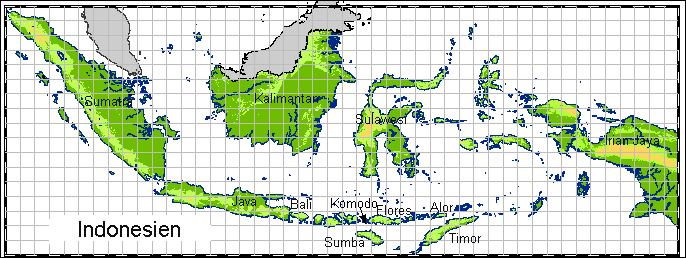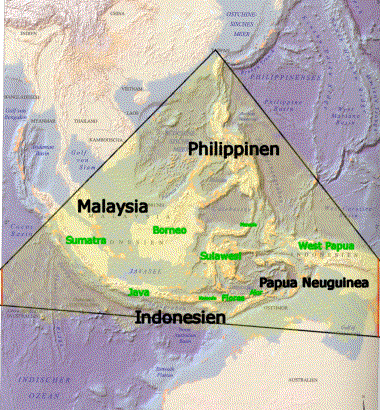Diving in the centre of biodiversity
The Asian Pacific centre of biodiversity
The triangle formed by the Philippines in the north and bordered in the west by the western shores of Indonesia, then leading east well beyond the edge which is normally considered West Pacific (Great Barrier Reef, Coral Sea, the Solomon Islands and Vanuatu) and on north to New Guinea and eastern Indonesia is the centre of marine biodiversity in the world. This triangle is home of the most bio-diverse population of reef fishes, corals and crustaceans on Earth. Nowhere else on this world is reached a similar density of marine species. The table below underlines the exceptional status of this region.| Regional biodiversity in coral reefs (Number of species) | |||
| Taxonomic Group | Asian Pacific | Caribbean | East Atlantic |
| Hard Coral | 719 | 62 | 0 |
| Soft Coral | 690+ | 6 | 0 |
| Sponges | 244 | 117 | 0 |
| Mollusks | 494 | 63 | 31 |
| Crustaceans | 340 | 118 | 30 |
| Fishes | 4000 | 1400 | 450 |
| Quoted from: Spalding, Mark. D., Ravilious, C., Green, E.P., Weltatlas der Korallenriffe, Bielefeld 2001 | |||
What is the reason for these big differences?
Scientists assume that the whole area of the Atlantic Ocean suffered a mass-extinction of species during the last ice ages. Many species of corals and animals living in coral reefs disappeared during this time. Nowadays there are only seven species of corals left which can be found in both regions. Even after the end of the last ice age and the improvement of environmental conditions for coral growth the number of species in the Atlantic never reached its former numbers. Since the end of the last ice age there was simply not sufficient time for the development of new species in great numbers.As a result of this historical process the Atlantic reefs (including the Caribbean reefs) host fewer species than the Asia Pacific region. Biodiversity of corals is less than one tenth and of fishes one third compared to the Asian Pacific.
In the Asian Pacific region the mass extinction did not take place. Here in protected areas species survived the ice ages. That is why today biodiversity is so high in this area. Further east towards the central Pacific the number of species declines significantly.
In the centre of this triangle of biodiversity the number of species surpasses the numbers in all other areas on the world. Here you will find in certain bays or around small islands more species than in the whole Caribbean. These hotspots of biodiversity are of course the main destinations of ambitious divers.
In Indonesia the areas of special interest are Sulawesi, Bali and the islands east of Bali especially Komodo, Flores and Alor. Further east the Moluccas (Maluku) Islands and the western tip of New Guinea with the Raja Ampat Islands are important hotspots of biodiversity.
In a research report on the bay of Maumere from 1997 Kuiter & Allen counted 1133 species of fish just in this bay. This is still the highest number of species of fish ever counted in a specific area.
In the area of the Tukang Besi Islands (Wakatobi) in the south-east of Sulawesi the counted number of species of fish is at least 430 and Gerald Allen, world-famous ichthyologist, counted during a single dive near the western tip of New Guinea, the Raja Ampat Islands, 284 different species of fish. In the same area 465 different species of corals were found. Scientists believe, that this hotspot is the world´s top spot of biodiversity.
There are few research results on the other hotspots in Indonesia. But there is no doubt that Manado and Lembeh in the north of Sulawesi and the Nusatenggara Islands east of Bali up to Alor are further regional centers of biodiversity.
In the centre of this triangle of biodiversity the number of species surpasses the numbers in all other areas on the world. Here you will find in certain bays or around small islands more species than in the whole Caribbean. These hotspots of biodiversity are of course the main destinations of ambitious divers.
In Indonesia the areas of special interest are Sulawesi, Bali and the islands east of Bali especially Komodo, Flores and Alor. Further east the Moluccas (Maluku) Islands and the western tip of New Guinea with the Raja Ampat Islands are important hotspots of biodiversity.
In a research report on the bay of Maumere from 1997 Kuiter & Allen counted 1133 species of fish just in this bay. This is still the highest number of species of fish ever counted in a specific area.
In the area of the Tukang Besi Islands (Wakatobi) in the south-east of Sulawesi the counted number of species of fish is at least 430 and Gerald Allen, world-famous ichthyologist, counted during a single dive near the western tip of New Guinea, the Raja Ampat Islands, 284 different species of fish. In the same area 465 different species of corals were found. Scientists believe, that this hotspot is the world´s top spot of biodiversity.
There are few research results on the other hotspots in Indonesia. But there is no doubt that Manado and Lembeh in the north of Sulawesi and the Nusatenggara Islands east of Bali up to Alor are further regional centers of biodiversity.
Dive destinations in the centre of biodiversity
(Please click)


